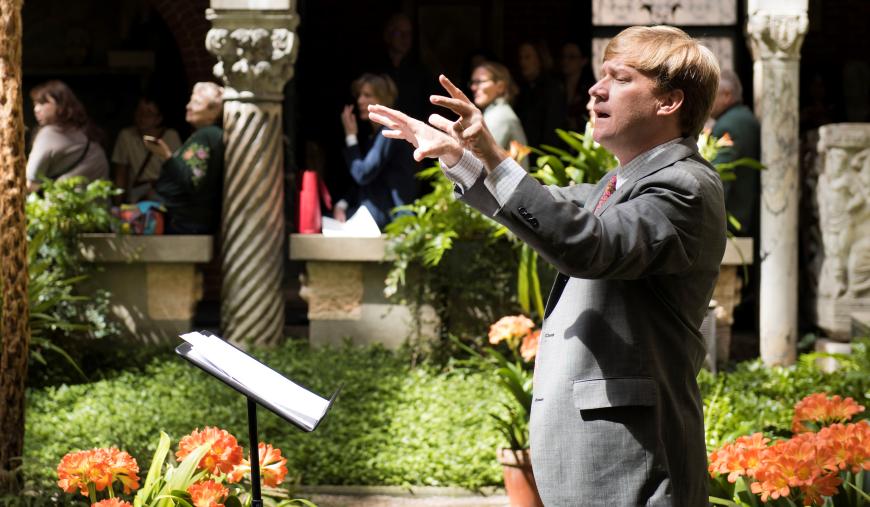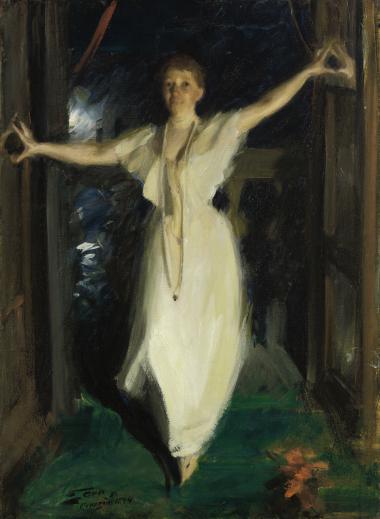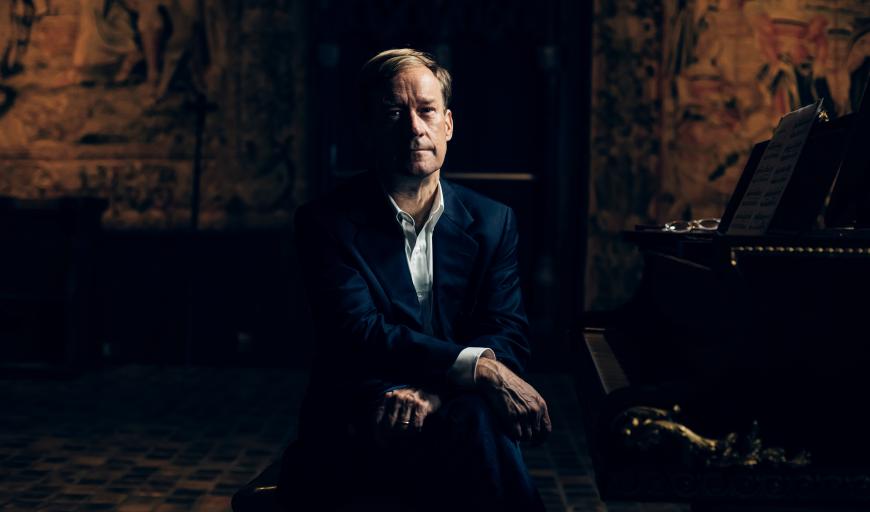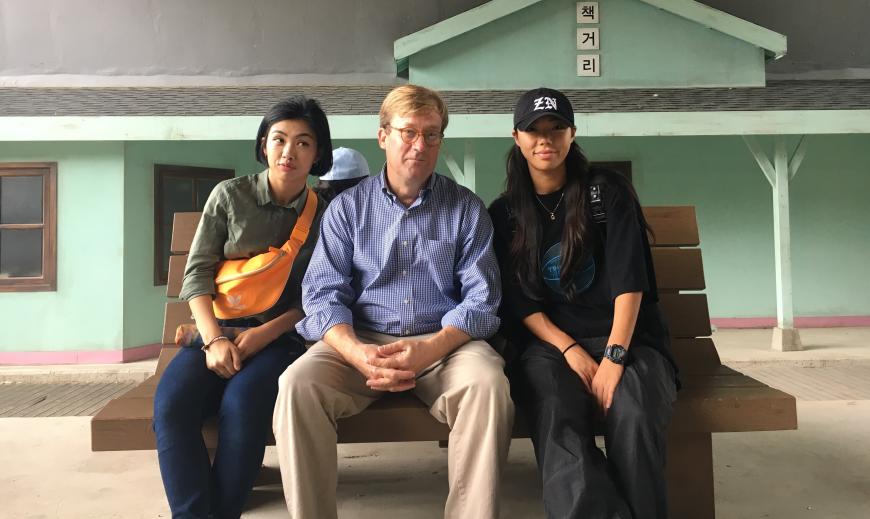
Every two years, the Rubin Institute for Music Criticism convenes in San Francisco, teaching music students across the U.S. about music journalism. SF Classical Voice has partnered with the Rubin Institute to give the program’s top writers more experience in the field with an internship. This year’s Rubin winners, Emery Kerekes and Lev Mamuya, will be with SFCV for six months, reporting from New York and Boston, respectively.
Anyone who assumes that Boston’s Isabella Stewart Gardner Museum is, like many museums, purely a repository of visual works is missing something important. Home to the oldest museum-based concert series in the country, the Gardner has, of late, presented some of its most vital and inventive live performances. The mind behind the programming? George Steel, the museum’s Abrams curator of music.
Steel is no stranger to music in the museum context and has served to great acclaim as a curator of interdisciplinary programs and an interrogator par excellence of classic works. But his fit for the post goes beyond experience — Steel seems especially galvanized by the Gardner’s ethos of invention, going back to its founder.

Whether collecting historical works of little renown in her lifetime or supporting the work of living artists, composers, and writers, Isabella Stewart Gardner’s curatorial philosophy promoted both the recontextualization of historical works and the promotion of new voices. “[Isabella] was intensely interested in what was next and had a great zeal to convert other people to loving it as much as she did. … I think that spirit needs to permeate the concert series,” said Steel in a recent chat.
At the Gardner, Steel is curating programming that expands not only the institution’s gaze but the living canons of several art forms at large. In the past few years, site-specific operas have cast the museum’s iconic tapestries in new relief. Helga Davis’s companion program to the Botticelli: Heroines + Heroes exhibit brought “contemporary practices to historic narratives,” in the words of I Care if You Listen’s Amanda Cook. And recent concerts in the warm, hive-like Calderwood Hall have featured truly scintillating performers, such as pianist Aaron Diehl and the Sphinx Virtuosi.
It’s a slate of programming almost dizzying in its scope. But Steel is in his element and relishing his position. “There’s a lot of work to be done. But it’s exactly what I’m supposed to be doing,” he said. And as I watched him mix among exhilarated concertgoers after a recent performance by the Baroque ensemble ACRONYM, it was clear that, with Steel, the Gardner’s celebrated series is in uniquely capable hands.
The ISGM is a unique institution that resists easy explanation to non-Bostonians. Situated a stone’s throw from the city’s Museum of Fine Arts, Boston’s largest, most prominent survey museum, it has long embraced idiosyncrasy. Its collections, which mix histories and cultures across disciplines from painting to horticulture, defy categorization. And at the museum, there has always been music.
Despite strict stipulations in Gardner’s will that prohibit the rearrangement of the works on show, the spirit of invention is still a guiding principle of the museum’s identity. I grew up in Boston, and the museum grew with me, always deepening the context in which the works from its permanent collection are understood and adding a new wing in 2012, which often champions the work and scholarship of contemporary voices.

Under Steel, music figures strongly in maintaining this innovative ethos. Since beginning his work as a guest curator more than five years ago, he has furthered the extent to which musical programming drives the reexamination and reformation of the canon the museum exhibits and promotes.
Since contributing to the ISGM’s strategic plan in 2019, Steel has been a champion of underrepresented works and performers, predating the forced pandemic-era reckoning with representational injustice undertaken by many of the field’s largest institutions (works by women and composers of color make up 40 percent of all works on ISGM programs).
A tireless scholar and archivist, Steel reaches past the obvious. “Folks in positions like mine have the most powerful position to make change. Performers often advocate for music they believe in, but they need institutions to support that work and present it to the public. And at the museum, I [also] have the luxury and the duty of being able to find new works. It’s important to not only find great music that’s been overlooked but to do the hard work — finding heirs, paying royalties, getting an engraving — that should have been done the moment the piece was written but never happened. I find that work profoundly satisfying.”
In our conversation, George regaled me with tales of connecting with Cuban musicologists to program a showpiece by José White Lafitte and engraving a near-lost violin sonata by William Dawson. Not only has Steel excelled in this work, but he has also succeeded in putting the music in the hands of able performers — the pieces that have become concert favorites of violinists In Mo Yang and Randall Goosby, respectively.
“Engaging new performers with these works, of course, takes relationship-building,” said Steel. His relationships, which are wide-ranging, have also added considerable heft to the Gardner’s contemporary programming. The coming season will feature, amongst other nationally significant highlights, a celebration of John Zorn’s 70th birthday, the JACK Quartet presenting music of Jeffrey Mumford, and newly commissioned dance works from choreographer Claudia Schreier.
This mixture of media is one of Steel’s other points of pride in his work at the Gardner. In continuation of his Miller Theatre legacy, Steel has continued to commission dance and use it to animate classic works (this coming season will pair Schreier’s works with solo Bach from violinist Geneva Lewis). And at the ISGM, the presence of curators from sculpture to horticulture experts has pushed Steel’s spirit of multidisciplinary programming further.

He understands there should be a synergy between his work and that of the museum’s curators of visual works. Said Steel: “Seeing the inside process of curators [when I first got to the Gardner], I saw exhibits that were built, yes, upon scholarship and aesthetic sense, but also contained the theatricality of shows. Thinking of the museum as a show-making institution alongside its many other roles, building in concerts fits in naturally.” In collaboration with Ruettgers Curator of Landscape Charles Waldheim, Steel’s next program will examine the relationship between music and landscape, “both in ways one might expect but also [in] the surprising diversity of ways that influence between the two can take place.”
In an interview, ISGM Director Peggy Fogelman was keen to stress the importance of the word “curator” to Steel’s role and work: “It’s a museum that has a much more interdisciplinary and wide-ranging understanding of creativity than you might find in a traditional art museum. … [The music programming] is a curatorial endeavor that works as part of the creative enterprise of the museum as a whole. In our curatorial forum, in which curators pitch ideas to each other and to me, we always think about ways that an interdisciplinary spirit can present itself across all our programming.”
Though he still travels in from New York, Steel is building a home and a legacy in Boston and helping keep one of the city’s freshest institutions vibrant. If you should make plans to visit this museum, don’t forget to check the performance schedule.



